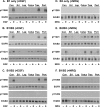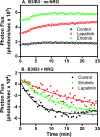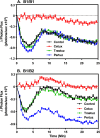Dynamic analysis of the epidermal growth factor (EGF) receptor-ErbB2-ErbB3 protein network by luciferase fragment complementation imaging
- PMID: 24014028
- PMCID: PMC3798547
- DOI: 10.1074/jbc.M113.489534
Dynamic analysis of the epidermal growth factor (EGF) receptor-ErbB2-ErbB3 protein network by luciferase fragment complementation imaging
Abstract
ErbB3 is a member of the ErbB family of receptor tyrosine kinases. It is unique because it is the only member of the family whose kinase domain is defective. As a result, it is obliged to form heterodimers with other ErbB receptors to signal. In this study, we characterized the interaction of ErbB3 with the EGF receptor and ErbB2 and assessed the effects of Food and Drug Administration-approved therapeutic agents on these interactions. Our findings support the concept that ErbB3 exists in preformed clusters that can be dissociated by NRG-1β and that it interacts with other ErbB receptors in a distinctly hierarchical fashion. Our study also shows that all pairings of the EGF receptor, ErbB2, and ErbB3 form ligand-independent dimers/oligomers. The small-molecule tyrosine kinase inhibitors erlotinib and lapatinib differentially enhance the dimerization of the various ErbB receptor pairings, with the EGFR/ErbB3 heterodimer being particularly sensitive to the effects of erlotinib. The data suggest that the physiological effects of these drugs may involve not only inhibition of tyrosine kinase activity but also a dynamic restructuring of the entire network of receptors.
Keywords: Cancer Biology; Epidermal Growth Factor (EGF); Epidermal Growth Factor Receptor (EGFR); ErbB2; ErbB3; Growth Factors; Receptor Tyrosine Kinase.
Figures










Similar articles
-
ErbB3 expression and dimerization with EGFR influence pancreatic cancer cell sensitivity to erlotinib.Cancer Biol Ther. 2007 Apr;6(4):548-54. doi: 10.4161/cbt.6.4.3849. Cancer Biol Ther. 2007. PMID: 17457047
-
Suppression of heregulin β signaling by the single N-glycan deletion mutant of soluble ErbB3 protein.J Biol Chem. 2013 Nov 15;288(46):32910-21. doi: 10.1074/jbc.M113.491902. Epub 2013 Oct 4. J Biol Chem. 2013. PMID: 24097984 Free PMC article.
-
Quantitation of the effect of ErbB2 on epidermal growth factor receptor binding and dimerization.J Biol Chem. 2012 Sep 7;287(37):31116-25. doi: 10.1074/jbc.M112.373647. Epub 2012 Jul 20. J Biol Chem. 2012. PMID: 22822073 Free PMC article.
-
The ErbB/HER family of protein-tyrosine kinases and cancer.Pharmacol Res. 2014 Jan;79:34-74. doi: 10.1016/j.phrs.2013.11.002. Epub 2013 Nov 20. Pharmacol Res. 2014. PMID: 24269963 Review.
-
Small molecule inhibitors targeting the EGFR/ErbB family of protein-tyrosine kinases in human cancers.Pharmacol Res. 2019 Jan;139:395-411. doi: 10.1016/j.phrs.2018.11.014. Epub 2018 Nov 27. Pharmacol Res. 2019. PMID: 30500458 Review.
Cited by
-
Mechanisms of activation of receptor tyrosine kinases: monomers or dimers.Cells. 2014 Apr 22;3(2):304-30. doi: 10.3390/cells3020304. Cells. 2014. PMID: 24758840 Free PMC article.
-
Whole-exome and targeted gene sequencing of gallbladder carcinoma identifies recurrent mutations in the ErbB pathway.Nat Genet. 2014 Aug;46(8):872-6. doi: 10.1038/ng.3030. Epub 2014 Jul 6. Nat Genet. 2014. PMID: 24997986
-
EGFR forms ligand-independent oligomers that are distinct from the active state.J Biol Chem. 2020 Sep 18;295(38):13353-13362. doi: 10.1074/jbc.RA120.012852. Epub 2020 Jul 29. J Biol Chem. 2020. PMID: 32727847 Free PMC article.
-
Endothelial Cells Promote Colorectal Cancer Cell Survival by Activating the HER3-AKT Pathway in a Paracrine Fashion.Mol Cancer Res. 2019 Jan;17(1):20-29. doi: 10.1158/1541-7786.MCR-18-0341. Epub 2018 Aug 21. Mol Cancer Res. 2019. PMID: 30131447 Free PMC article.
-
A Combination of Conformation-Specific RAF Inhibitors Overcome Drug Resistance Brought about by RAF Overexpression.Biomolecules. 2023 Aug 2;13(8):1212. doi: 10.3390/biom13081212. Biomolecules. 2023. PMID: 37627277 Free PMC article.
References
-
- Garrett T. P., McKern N. M., Lou M., Elleman T. C., Adams T. E., Lovrecz G. O., Zhu H.-J., Walker F., Frenkel M. J., Hoyne P. A., Jorissen R. N., Nice E. C., Burgess A. W., Ward C. W. (2002) Crystal Structure of a truncated epidermal growth factor receptor extracellular domain bound to transforming growth factor a. Cell 110, 763–773 - PubMed
-
- Ogiso H., Ishitani R., Nureki O., Fukai S., Yamanaka M., Kim J.-H., Saito K., Sakamoto A., Inoue M., Shirouzu M., Yokoyama S. (2002) Crystal structure of the complex of human epidermal growth factor and receptor extracellular domains. Cell 110, 775–787 - PubMed
-
- Ferguson K. M., Berger M. B., Mendrola J. M., Cho H.-S., Leahy D. J., Lemmon M. A. (2003) EGF Activates its receptor by removing interactions that autoinhibit ectodomain dimerization. Mol. Cell 11, 507–517 - PubMed
Publication types
MeSH terms
Substances
Grants and funding
LinkOut - more resources
Full Text Sources
Other Literature Sources
Research Materials
Miscellaneous

